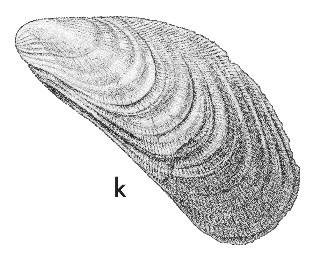
Revised descriptions of New Zealand Cenozoic Mollusca from Beu and Maxwell (1990)

 | Revised descriptions of New Zealand Cenozoic Mollusca from Beu and Maxwell (1990) | 
|
  (Pl. 16k): GS951A, J41/f8475, Target Gully Shellbed, Oamaru, Altonian (GNS) |
Beu & Maxwell (1990): Chapter 11; p. 178; pl. 16 k.
Synonymy: Mytilus striatus Hutton 1885b, p. 332 (not of Montague, 1803, etc.); Mytilus huttoni Cossmann 1916, p. 11 (new name for M. striatus Hutton, preoccupied); M. (Aulacomya) huttoni
Classification: Mytilidae: Mytilinae
Description: Size moderate for family (length 35-50 mm), mytiliform (i.e. beaks terminal), strongly inflated; dorsal margin long, almost straight; ventral margin weakly concave. Radial sculpture of numerous, narrow, low, flattened costellae, additional ones appearing during growth by intercalation as well as by bifurcation, those on posterior area swinging around towards dorsal margin, so producing a divaricate pattern. Radial costellae absent from proximal part of anterior area. Commarginal sculpture of growth lines. Interior nacreous, margins finely crenulate. Anterior adductor muscle scar elongate, close to umbo; posterior scar subquadrate. Ligamental groove parallel to, and somewhat below dorsal margin, extending almost entire length of margin.
Comparison: Trichomya huttoni is readily distinguished from other New Zealand mytilids by its moderately large size, its mytiliform shape, and its fine radial sculpture. A related species, characterised by its larger size, its more alate shape and its more strongly concave ventral margin, is recorded from the Harper River, Canterbury (Waitakian). The genus is extinct in New Zealand but still lives in Australia, byssally attached to hard substrates in shallow water (less than 20 m). Specimens collected after 1990 suggest that this species has an umbonal septum and should probably be classified in Septifer, but this group requires further study. The type species of Trichomya, T. hirsuta (Lamarck, 1819), lives now commonly in the intertidal zone, byssally attached to rocks, in eastern and southern Australia. It also occurs fossil abundantly in a single Mangapanian or early Nukumaruan shellbed in Wanganui Basin, although unfortunately the locality is uncertain at present.
Distribution: Altonian; "Broken River" (type — probably from the Altonian shellbed at the base of the Enys Formation, junction of Porter and Thomas Rivers); Target Gully Shellbed, Oamaru (not uncommon); Awamoa Creek (rare).
Cite this publication as: "A.G. Beu and J.I. Raine (2009). Revised
descriptions of New Zealand Cenozoic Mollusca from Beu and Maxwell (1990). GNS
Science miscellaneous series no. 27."
© GNS Science, 2009
ISBN
978-0-478-19705-1
ISSN 1177-2441
(Included with a PDF facsimile file
copy of New Zealand Geological Survey Paleontological Bulletin 58 in CD version
from: Publications Officer, GNS Science, P.O. Box 30368 Lower Hutt, New
Zealand)